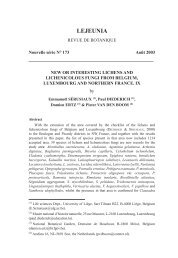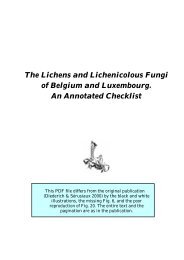A Synopsis of the Genera Skyttea, Llimoniella and - Lichens of ...
A Synopsis of the Genera Skyttea, Llimoniella and - Lichens of ...
A Synopsis of the Genera Skyttea, Llimoniella and - Lichens of ...
Create successful ePaper yourself
Turn your PDF publications into a flip-book with our unique Google optimized e-Paper software.
436 THE LICHENOLOGIST Vol. 32<br />
Distribution. Austria, France (Corsica), Great Britain, Irel<strong>and</strong>, Italy,<br />
Norway, Russia, Spain, Canary Isl<strong>and</strong>s, Madeira, Kenya, USA, Argentina,<br />
Subantarctic Isl<strong>and</strong>s (Prince Edward Isl<strong>and</strong>, Marion Isl<strong>and</strong>) (Santesson 1960,<br />
1993; Triebel 1989; Hafellner & Turk 1995; H<strong>of</strong>mann et al. 1991; Triebel<br />
et al. 1991; Kalb & Hafellner 1992; Hafellner 1993, 1994a, b, 19966).<br />
Observations. As <strong>the</strong> type specimen <strong>of</strong> S. elachistophora comprises a relatively<br />
small number <strong>of</strong> ascomata in a good condition, we did not make a complete<br />
study <strong>of</strong> this fungus, <strong>of</strong> which a modern description is available in Sherwood<br />
et al. (1981). The lateral exciple is, however, not 'brown, without any greenish<br />
tint' as stated by <strong>the</strong>se authors, but distinctly greenish in large parts, <strong>and</strong><br />
brownish only in <strong>the</strong> uppermost region. In KOH, <strong>the</strong> greenish pigment<br />
becomes olivaceous, whilst <strong>the</strong> brown region remains (reddish) brown. We<br />
confirm <strong>the</strong> presence <strong>of</strong> unusually large outer excipular cells, a character<br />
stressed by Sherwood et al. (1981).<br />
In <strong>the</strong> protologue <strong>of</strong> 5. tephromelarum, that species was said to differ from 5".<br />
elachistophora by an olivaceous exciple <strong>and</strong> shorter excipular hairs (12-20 |im<br />
long, versus 40-50 um). However, <strong>the</strong> excipular pigments are exactly <strong>the</strong> same<br />
in <strong>the</strong> material studied by us, <strong>and</strong> <strong>the</strong> excipular hairs in <strong>the</strong> material growing<br />
on Tephromela appear to be quite variable, with hairs over 40 |im long<br />
dominant in some specimens (e.g. Hafellner 32807).<br />
The host <strong>of</strong> <strong>the</strong> type specimen <strong>of</strong> S. elachistophora is sterile <strong>and</strong> in a poor<br />
condition. It has been examined by Sherwood et al. (1981: 484) who stated<br />
that it contains atranorin <strong>and</strong> confluentic acid (examined by TLC by P. W.<br />
James) <strong>and</strong> who proposed that it might be a Lecidea s. lat. Rambold (in Triebel<br />
1989) noticed a morphological <strong>and</strong> chemical resemblance with Tylothallia<br />
biformigera. As all o<strong>the</strong>r known <strong>Skyttea</strong> species are highly specialized<br />
fungi growing on one single host genus or species, it seems unlikely that<br />
S. elachistophora is confined to two non-related host genera, Tephromela<br />
(Bacidiaceae) <strong>and</strong> Tylothallia (Lecanoraceae). It is also unlikely that Tylothallia<br />
biformigera is a misunderstood species <strong>of</strong> Tephromela. As long as <strong>the</strong> identity<br />
<strong>of</strong> <strong>the</strong> host is not correctly understood, <strong>and</strong> no recent collections <strong>of</strong> a <strong>Skyttea</strong><br />
on Tylothallia are made, we believe that it is best to consider both taxa<br />
5. elachistophora <strong>and</strong> S 1 . tephromelarum as conspecific, growing on Tephromela<br />
<strong>and</strong> an unidentified crustose lichen.<br />
Triebel (1989) mentioned an additional specimen <strong>of</strong> 5. elachistophora on<br />
Carbonea montevidensis from Bolivia. We re-examined <strong>the</strong> Bolivian material<br />
{Feuerer 12432d) <strong>and</strong> found that this specimen represents a distinct species,<br />
S. carboneae (for differences, see under that species).<br />
Additional specimens examined (all on T. atra; unless o<strong>the</strong>rwise mentioned, all saxicolous).<br />
Austria: Kdrnten: Nationalpark Hohe Tauern, Tauerntal NW von Mallnitz, 1989, Hafellner<br />
24252, 28432 (GZU). Steiermark: Gurktaler Alpen, Frauenalm S von Murau, v 1981, Poelt<br />
(GZU); ibid., 1983, Poelt (2 spec.) & Hafellner 10364 (GZU). Tirol: Otztaler Alpen, in der Klamm<br />
E ober Pfunds, 1991, Hafellner 30223 (GZU).—France: Haute-Corse: Monte d'Oro-Massiv,<br />
Kuppe N ober dem Col de Vizzavona, 1993, Hafellner 3157'6 (GZU).—Great Britain: Scotl<strong>and</strong>:<br />
V.C. 102, South Ebudes: Islay, 3-4 km S <strong>of</strong> Port Askaig, Baleachdrach, 1992, Coppins 15118<br />
(E).—Norway: Hordal<strong>and</strong>, Odda, 1984, Hafellner 12025 (GZU); Hordal<strong>and</strong>, Voss, 1984,<br />
Hafellner 14502 (GZU).—Russia: Karelia, Karelia ladogensis, Sortavala, Valamo, Bajonnoi, vii<br />
1938, Pankakoski (H, hb. Diederich).—Spain: Alava, near Murua, c. 15 km NNW <strong>of</strong> Vitoria, on





